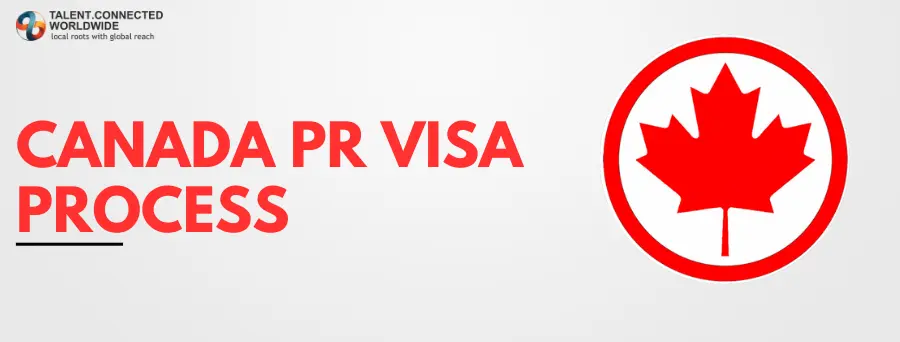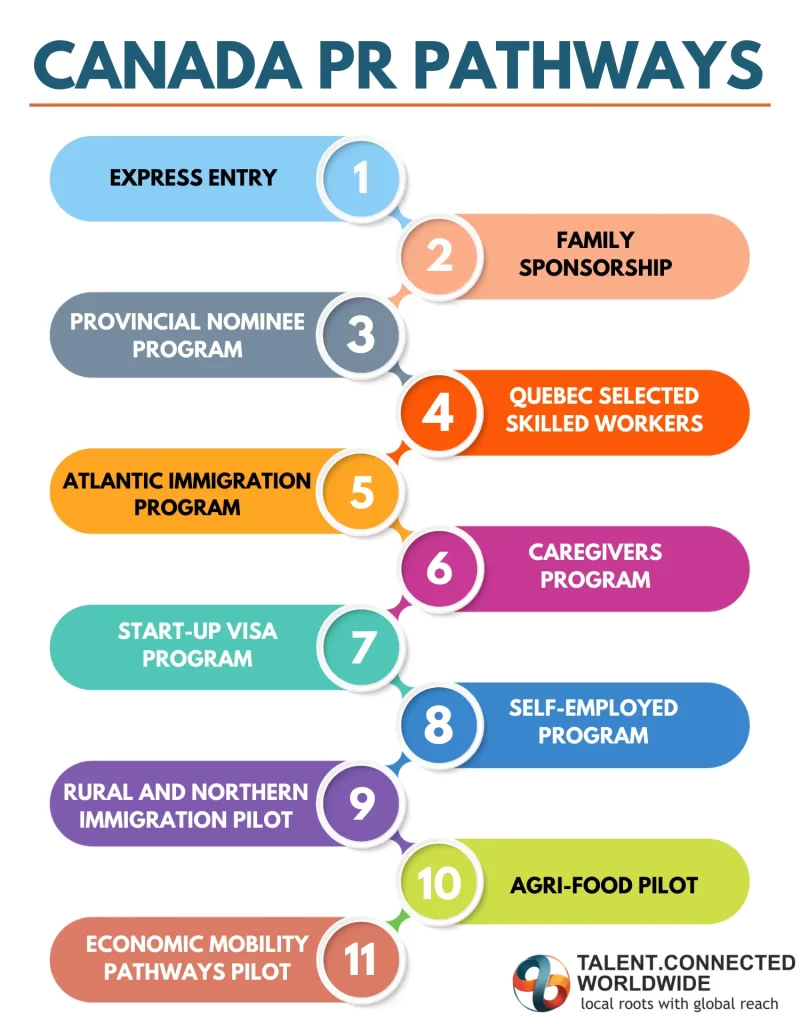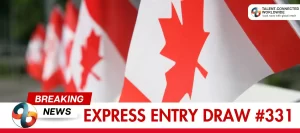
A Canada PR visa is the official document issued by Canadian immigration authorities that allows a permanent resident to enter and leave Canada. To obtain a PR visa, you can apply for permanent residency through any of the various immigration pathways. Some popular programs that offer an easier Canada PR visa process are Express Entry, Provincial Nominee Program, Start-Up Visa, Quebec Skilled Worker Program, etc.
In this blog, learn about how you can apply online to obtain permanent residency through various IRCC offered immigration pathways. We will be mentioning the steps in detail.
Download Free Immigration and PR Guide PDF
Canada PR Pathways
You can apply for Canadian residency through these programs:
- Express Entry
- Family Sponsorship
- Provincial Nominee Program
- Quebec Selected Skilled Workers
- Atlantic Immigration Program
- Caregivers program
- Start-Up Visa program
- Self-Employed program
- Rural and Northern Immigration Pilot
- Agri-Food Pilot
- Economic Mobility Pathways Pilot

1. Express Entry
Express Entry is basically the fastest way to obtain residency in Canada. It is for skilled workers and assists candidates to become a PR holder within 5-7 months. There are three programs under Express Entry that help eligible skilled workers immigrate to the country- Federal Skilled Worker Program, Federal Skilled Trades Program, and Canadian Experience Class.
Follow the below steps to successfully complete Canada PR process through the Express Entry process:
#1 Step: Create Express Entry profile
First of all, you need to create an Express Entry profile which is created online. In this profile, you’ll provide information about your age, education, work experience, language proficiency, etc.
#2 Step: Get a Comprehensive Ranking System (CRS) score
Once you have created the profile, you will get a Comprehensive Ranking System (CRS) score which is evaluated based on the information of your profile. Whatever CRS score you receive will determine whether you will get an ITA in an Express Entry draw.
Once your profile is created and found eligible, it will be put in the Express Entry pool with other eligible profiles. Remember, the higher you score, the better it is for you.
#3 Step: Express Entry draw
Now that your profile is in the pool, you will wait for IRCC to conduct an Express Entry draw. Whenever this draw takes place, it will invite high-ranking candidates from the pool who meet the rounds’ instructions.
Also, while there’s no draw happening, you can update any relevant information in your profile so that it remains up to date. Keeping the profile updated is an important step to remember.
#4 Step: Invitation to Apply (ITA)
When the Express Entry draw happens, and you receive an Invitation to Apply, you will be able to apply for permanent residency through Express Entry. You must have received an Invitation to Apply (ITA) before you even think of applying for PR through Express Entry.
The ITA that you have received from the Express Entry draw will be valid for the next 60 days (2 months). This is the period of time you have to fill out the application form correctly and submit it before your ITA expires.
#5 Step: Filling out the PR application
Now, start filling out the permanent residency application online. To fill out the application form, sign in to your IRCC account and start filling out the application.
#6 Step: Upload the documents
When you are filling out the PR application, there are many documents that you will need to upload. To upload these documents, you must first scan them and then you can upload them.
In case any of your documents are in another language than English or French, you must translate them and then upload the translated documents.
After you are done uploading the documents, move on to the next step, which is paying the required fees.
#7 Step: PR fees
Once you are done filling out the form and scanning, and uploading the necessary documents, it is time you pay the required fees for Canada PR.
The fee includes:
- PR application processing fee – $950
- Right of Permanent Residence fee – $575
- Biometrics fee – $85
- Total – $1,610
The biometrics for Canada PR consist of a person’s fingerprints and photographs to establish their individual identity. The Canadian authorities use it to identify scammers faking to be someone else. Once you give your biometric information, you don’t have to provide it again for the next 10 years.
You can either pay the Right of Permanent Residence in this step or wait for your PR application to be approved first. Either way is fine.
#8 Step: Application processing time
The standard processing time of a Canada PR visa application is about 8 months according to Immigration, Refugees and Citizenship Canada (IRCC).
If you have applied for Canada PR through the Canadian Experience Class, your application may even be processed within 5 months. This Canada PR visa processing time is calculated after biometrics.
In case you are applying through the Federal Skilled Worker Program, it may take your application about 6 months to get processed. This Canada PR visa processing time includes the time it takes to give biometrics.
See how fast PR applications get processed through Express Entry. The pathway’s name does not contain “express” for nothing.
#9 Step: Decision on our application
Once IRCC makes a decision on your PR application, they will inform you of it through your online account.
If the PR application is accepted, go ahead and pay the Right of Permanent Residence fee (if you haven’t done so already). Once the fee is paid, you will receive a Confirmation of Permanent Residence (COPR) and a Canada PR visa. A visa will be issued to you if you belong to a country that requires a visa.
#10 Step: Confirm your PR status
To confirm your permanent resident status, you don’t need to do anything until IRCC contacts you for the same. They will send you an email or contact you using your phone number.
The confirmation can be done through a secure online portal which means you don’t even need to attend an offline interview.
#11 Step: After receiving residency
Now that you have received permanent resident status, IRCC will create an e-COPR which you can see in the online Portal. Do you know that this e-COPR is proof of your residency?
Moreover, IRCC will also ask you to upload a photograph of yourself so that they can begin creating your permanent resident card. Since this is the first time you’ve applied for PR, IRCC will issue you a PR card itself.
A resident does not need to apply for their first PR card. However, if the card is lost or stolen, or destroyed, you will have to apply for it again and pay the fees as well.
#12 Step: Arrival in Canada
At the time you arrive in Canada, you must possess:
- Your passport or travel documents; it must be a regular citizen passport and not a diplomatic one)
- Proof of funds to financially support yourself as well as your family
- Your confirmation of permanent residence along with the Canada PR visa; if IRCC issued you a visa, you must have it at the time of your arrival in Canada
After you arrive, a Canada Border Services Agency officer will meet up with you to:
- ensure you’re not entering Canada after your COPR has expired
- check your identity and make sure you are the right person; they’ll use biometrics to check your identity
- see if you’re admissible in Canada or not
- check not only your passport but also your travel documents
In case you provide any information that is not true or incomplete, the CBSA officer may not let you enter Canada. If everything is alright and you’re found admissible, the CBSA officer will allow you to enter Canada as a PR.
If you have CAN$10,000 or more, you must let the CBSA officer know about it otherwise you may have to pay a fine and your funds may be seized.
So, this is the Canada PR visa process through Express Entry! Now, let’s move on to how to obtain a Canada PR visa via Family Sponsorship.
2. Family Sponsorship
Family Sponsorship program lets a Canadian permanent resident or citizen to sponsor their spouse/ common-law partner/ dependent children/ family members/ relatives for permanent residence in Canada.
Sponsoring means that you will be financially supporting the person being sponsored for a certain period of time. To sponsor a person, you will not only submit a sponsorship application but also the permanent residence application to IRCC.
Following are the steps of Canada PR process via the Family Sponsorship program:
#1 Step: Fill the Sponsor Application
You must fill out the application to sponsor. For this, you will have to be eligible, complete the PDF forms, and sign these digital forms.
The person being sponsored must also be eligible, upload these PDFs to their application, and electronically sign the application.
#2 Step: Apply for PR
The person being sponsored will be the one to fill out an application for permanent residency.
#3 Step: Pay the application fee
The person who is applying for PR will pay the permanent residency fee. Along with the application fee, they will pay the biometric fee, if they haven’t given biometrics already.
The overall family sponsorship application fee is CAN$1,080.
#4 Step: Send more information
While your PR application is being processed, IRCC may require more information. They’ll probably ask you to provide a police clearance certificate (PCC), your medical exam results, and biometrics.
#5 Step: Submit the application
Once you have completed your application, make sure you answered all the questions, signed the required applications, and uploaded the payment receipt as well.
#6 Step: Application processing
It might take your permanent residency application through the Family Sponsorship Program around 10-48 months to be processed. This is the Canada PR visa process time from India.
#7 Step: Application approval
If IRCC approves the PR application, they’ll send you a confirmation of permanent residence.
#8 Step: Arrival in Canada
When you arrive in Canada, you must show the COPR to the border services officers. Along with the COPR, you will also show your passport or other travel document to the officer.
Also, show the Canada PR visa if you were issued one. The officers would probably ask the family members questions to confirm their identity and information, and so the person being sponsored should answer them.
If they are bringing funds in any form, such as cash, stocks, money orders, bonds, traveler cheques, etc, they must inform the officer of this fund.
And this is how you get a Canada PR visa through the Family Sponsorship program.
3. Provincial Nominee Program
Provincial Nominee Programs (PNPs) select candidates based on their skills, work experience, education, and other requirements. Every province and territory of Canada has its own PNP, excluding Quebec and Nunavut.
NOTE: Quebec decides its own PNP allocations and Nunavut does not have a PNP program yet.
The aim of PNPs is to nominate or invite candidates based on factors such as their skills, work experience, whether they intend to live in that province and want to become PR, etc. Moreover, the application process depends on which stream of the PNP you choose to apply to.
Streams of each PNP target particular categories and have specific sets of requirements of their own. Some streams of the PNP may be linked to Express Entry while others may not. If a stream is linked to the Express Entry, the PNP will issue a nomination to the candidate. Upon being issued a provincial nomination, the candidate will receive an additional 600 CRS points.
In case the candidate applied to a stream that is non-Express Entry linked, the province/territory would issue them an invitation to directly apply for permanent residence of that province or territory. Hence, the application process depends on the stream.
Now, let’s understand this in detail below.
Canada Residency Process via Express Entry: PNP Version
#1 Step: Meet the Eligibility Requirements
Before you go ahead and apply for the stream, it is imperative that you check the eligibility criteria of the stream and make sure you qualify for it. Moreover, you also need to ensure that you meet the eligibility requirements of at least one of the three programs that come under Express Entry. These programs are- the Federal Skilled Worker Program, Federal Skilled Trades Program, and Canadian Experience Class.
#2 Step: Create an Express Entry Profile
Next, you can create an Express Entry profile and put in the required information. Once you are done, choose the provinces and territories that you are interested in. Now that you have let the provinces and territories know that you are interested in them, they might send you a “notification of interest” to your online account.
If you received a “notification of interest”, you may contact them and get a provincial nomination.
OR
You can also just contact the province or territory and apply for the same nomination. The aim is to get nominated after all.
#3 Step: Update your profile
Now that you have been nominated by a province/territory, you must reflect the same in your Express Entry profile. After that, an additional 600 points will be awarded to your profile.
In case you haven’t created an Express Entry profile yet, create one and then update the profile to let the system know that you received an extra 600 CRS points.
This huge increase of CRS points in your profile will surely help you get an invitation to apply for permanent residency.
#4 Step: Apply for PR!
Once you receive an invitation to apply, you can then start the process of applying for a Canada PR visa. Also, you can go through the whole process online.
When you are applying for Canada PR online through Express Entry under any PNP, it might take your application about 8 months.
Applying for PR visa through non-Express Entry process: PNP Version
#1 Step: Meet the Eligibility Requirements
As stated above, it is really important that you meet the eligibility criteria of whichever province/territory you want to live and work in. So, if you meet the eligibility requirements, go ahead and apply for a nomination.
#2 Step: Get nominated
To be eligible to apply for permanent residence through PNP, you must receive a nomination from that province or territory. Receiving a nomination means that you get an additional 600 CRS points.
#3 Step: Apply for PR!
Using the additional 600 CRS points, you may apply for Canada PR.
If you are not applying online through Express Entry, your PR application will take about 14 months to process.
If you don’t want to delay the application processing time, you should fill out the PR application with the correct and required information. In case the application is found incomplete or incorrect, IRCC might reject the application.
Then, you will need to complete the application or fix whatever error is there and re-submit the application, which will further take more time to process the application.
Now, this is the process to apply for a Canada PR visa through the Provincial Nominee Program (whether the stream is linked to Express Entry or not). Let’s move on to the next Canada immigration program, which is QSWP.
4. Quebec Selected Skilled Workers
The Quebec Selected Skilled Workers (QSWP) program is specifically designed for skilled workers who wish to settle down in Quebec by becoming PR of Canada.
Since Quebec has an agreement signed with the Government of Canada, the Canada-Quebec Accord, it allows the province to choose immigrant targets on its own. This is a privilege that no other province or territory of Canada has.
In order to move to Quebec through one of the Quebec immigration programs, there are two stages you must pass through:
- The first one requires you to get a Quebec Selection Certificate, which is known as Certificat de sélection du Québec (CSQ)in French. To get a CSQ, you would have to apply to the Quebec Government. Once you apply for a CSQ, Quebec will see if you meet the requirements to immigrate or not. In case your application is approved, you will receive a CSQ.
- In the second stage, you can apply to IRCC using the CSQ.
The PR application processing fee through the QSWP is $950 and the right of permanent residence fee is $575. Overall, the Canada PR visa fee through QSWP is $1,525. It takes about 10 months for your PR application to be processed under the QSWP.
Well, this is how you get a Canada PR visa through the Quebec Selected Skilled Worker program process.
5. Atlantic Immigration Program
The Atlantic Immigration Program (AIP) helps the Atlantic provinces of Canada invite candidates and hire them for specific job positions that are hard to fill otherwise.
Both international skilled workers as well as international graduates who graduated from Canada are targeted under this program. If they intend to live and work in any one of the four Atlantic provinces, they may be eligible for PR.
The Atlantic provinces are- New Brunswick, Nova Scotia, Newfoundland and Labrador, and Prince Edward Island.
The complete Canada PR process through the AIP is provided below!
#1 Step: Check your eligibility
The first thing you need to do is check if you are eligible for the program or not. You may need to meet the work experience requirements, language, education, and other requirements as well.
#2 Step: Get a Job Offer
Now that you are eligible, you need to get a job offer from an AIP employer who is designated. Only designated AIP employers can invite candidates through this program for Canadian permanent residency. Next up is preparing your documents!
#3 Step: Gather required documents
This is an important step as collecting all the required documents beforehand will immensely help you out while you are filling out the PR application.
#4 Step: Apply for PR!
Just create an online account on the Permanent Residence Portal or sign in using your username or email address and password to your account.
Once you are signed in, fill out the digital and PDF forms. There are forms for the employers to fill out too which you would be signing at the end by your hand.
#5 Step: Pay the PR Fees
The PR application processing fee through the AIP is $950 and the right of permanent residence fee is $575. This means the Canadian permanent residence fee when applied through the AIP is $1,525.The PR application processing time under the AIP is about 6 months.
#6 Step: Submit the PR application
Once you have completed the PR application, you may submit it. Just make sure that the application is complete with the required information and no document is missing.
In case there are any errors in the PR application, IRCC may reject it and you would have to resubmit the application after fixing the issues. To save time, double-check the application and only submit it once it’s complete.
Well, this is how you apply for a Canada PR visa through the AIP process.
6. Caregivers program
The Caregivers program allows you to live and work in Canada if you have at least 12 months of work experience as a caregiver within the last 36 months of applying.
There are two PR programs under the Caregivers program:
- Home Child Care Provider Pilot
- Home Support Worker Pilot
Once you apply through any of these pilots, IRCC will issue you a work permit. The work permit is necessary so that you can work in Canada while your PR application is being processed.
The PR application processing time under the Caregivers program is about 31-34 months.
There are two ways to get a work permit; one way is to opt for the work permit application process which will be linked to your PR application, while the other won’t be.
In case you chose the occupation-restricted open work permit application it’ll be linked to your PR application. If your PR application is being delayed in processing, your work permit application will also be delayed since they are related.
However, if IRCC informs you that you are eligible for PR, your work permit application shouldn’t take much longer.
The other way to get a work permit which will not be related to your PR application is to apply through TFWP. The employer you would be working for in Canada must be issued a positive LMIA to hire you. If you apply for a work permit through this way, chances are your permit application may get processed faster.
The fees for a Canada PR visa process through the Caregiver program without the work permit fee are:
- Application processing fee- $950
- Right of Permanent Residence fee- $575
- Total fee- $1,525
You must pay for the work permit separately and then include the receipts of both payments (PR visa fees + work permit application fees) in your PR application.
7. Start-up Visa
The Start-up Visa (SUV) program of Canada is designed to target immigrant entrepreneurs who wish to build their business in the country, however outside Quebec.
Moreover, the business that they wish to build must be:
- competitive on a global scale
- creative and innovative
- be able to create more jobs for Canadians
There are two ways to apply for immigration to Canada as an immigrant entrepreneur:
- Get a PR
- Get a work permit while your PR application is in process
Since the PR application process through the Start-up Visa program takes about 37 months to process, many prefer to get a work permit so they can work in Canada for the time being. The Start-up visa processing time mentioned here includes the time it takes to give biometrics.
Follow these steps to complete the Canada PR process without any trouble.
#1 Step: Get support from a Designated Organization
If you have a qualifying business idea, you should pitch that idea to a designated organization so that you can gain their support. It is absolutely necessary that the required designated organizations support your business idea and invest in it.
#2 Step: Meet the Requirements
Next up, you need to meet the necessary requirements such as language requirements, and bring enough money to settle in Canada.
#3 Step: Sign in/ Create an account on the PR portal
Now, you either need to create an online account on the PR portal or sign into your account.
Fill out the required digital and PDF forms on the portal as well.
#4 Step: Pay the PR Fees
This is when you pay the required fees online. This means you need to pay:
- The start-up visa application processing fee- $1,815
- Right of Permanent Residence fee- $575
- Biometrics- $85
- Total- $2,470
#5 Step: Submit the PR Application!
Once you are sure that your PR application is completed and no information is missing, you may submit the application. Just make sure that you have included all the documents.
IRCC tends to reject incomplete applications which leads to resubmission of PR applications by the candidates.
Apply for Work Permit
There’s a way for you to build your business in Canada while you are waiting for your PR application to get processed: apply for a work permit.
Since you are both the employer as well as the employee in the SUV program, there are two ways you can apply for the work permit:
- Create the employment offer and submit it for yourself
- You may either email IRCC, or
- Fill out the Employment forms in the portal and then pay the fees
- Apply for your work permit
- Collect all the necessary documents
- Get your document checklist so that you don’t miss any document
- Apply for the work permit through a safe, online portal
- Pay the fees online
To be eligible for this optional work permit, you must show that you have enough proof of funds and that your business will hugely benefit the Canadian economy.
Since this work permit is only for the SUV program, it is only valid for about 1 year and lets you work in Canada as an entrepreneur of your own business.
And this is how you obtain residency in Canada through the SUV program.
8. Self-Employed
If you are looking to immigrate to Canada as a self-employed person, check out the Self-Employed Persons Program. If you wish to be eligible for this program, you need to have the required experience in athletics or cultural activities. Also, you must be able to contribute to the athletic/cultural aspects of Canada.
The complete Canada permanent residence process under the self-employed persons program is as follows.
#1 Step: Create Online Account
The first thing you should do is either create or sign into your online PR application portal account. On this account, you must fill out the required digital and PDF forms.
#2 Step: Get your biometrics taken
If you haven’t given your biometrics before, you might need to give them now. Biometrics are your fingerprints and photographs that are used to establish your identity.
#3 Step: Pay the Fees
It is important that you pay the application processing fee, right of permanent residence fee, and biometrics fee and submit a copy of the receipts with your application.
You need to pay about $2,225. This fee is composed of the:
- Self-employed application processing fee- $1,810
- Right of Permanent Residence fee- $575
- Biometrics fee- $85
#4 Step: Submit the application
After you are done filling out the application, uploading all the necessary documents, and ensuring that the application is complete, you need to go ahead and submit it.
It might take your PR application through the Self-Employed Persons Program about 54 months to get processed (including the time it takes to give biometrics).
So, remember to submit a complete application so that IRCC doesn’t have to reject the application and you don’t have to submit it once again.
9. Rural and Northern Immigration Pilot
The Rural and Northern Immigration Pilot (RNIP) program helps smaller communities of Canada gain the benefits of immigration. Skilled workers who are willing to live and work in any one of the participating communities may be able to get Canada PR through RNIP.
Here are the Canada PR process steps to follow when you are applying via RNIP:
#1 Step: Meet the requirements
In whichever community you wish to immigrate to, you must check out its eligibility requirements as each community has its requirements. Moreover, you also need to meet the eligibility requirements set by IRCC when applying for Canadian PR.
#2 Step: Find a job
Now, you need to find a job whose employer must be part of one of the qualifying participating communities.
#3 Step: Get a job offer
When the employer issues you a job offer, you must submit an application for recommendation to the community.
#4 Step: Apply for PR
Once the community recommends you for PR, you may then proceed to apply for permanent residency in Canada through RNIP. Now, you must create/sign in to your online application portal account.
#5 Step: Fill out the form
In the online portal account, you need to fill out the necessary digital forms as well as PDF forms online. Further, there would be some forms for the employer to fill out as well. After filling out the forms, you need to give your biometrics.
#6 Step: Pay the PR application fee
Go ahead and pay the required fee once you are done filling out the application.
You need to pay:
- RNIP application processing fee- $950
- Right of Permanent Residence fee- $575
- Biometrics fee- $85
- Total- $1,610
#7 Step: Submit the PR application
Once you are done filling out the application and paying the fee, upload receipts of the payments in your PR application and then submit the application.
This is how you apply for a PR visa in Canada through the Rural and Northern Immigration Pilot program.
10. Agri-Food Pilot
The Agri-Food Pilot (AFP) program helps fill up particular occupations in certain industries of the agricultural sector by granting eligible non-seasonal workers permanent residency in Canada. Let’s see the application process for permanent residency through the AFP below.
#1 Step: Meet the requirements
To be eligible for this PR program, the candidate’s job offer as well as work experience must meet the eligibility criteria. Meeting requirements is an absolute necessity in this program. If you don’t meet requirements in both contexts, chances are, your PR application may be refused.
#2 Step: Create a PR account online
Start applying for your permanent residence application by creating an account online on the PR portal. In the portal, you will need to fill out various digital and PDF forms.
Some forms will be filled out by your employer but in the end, you will still need to sign them.
#3 Step: Give biometrics
If your age is between 14 to 79 years, you may need to give your biometrics information.
#4 Step: Pay the fees online
Next up is submitting the fee online. These fees include:
- AFP application processing fee- $950
- Right of Permanent Residence fee- $575
- Biometrics fee- $85
- Total- $1,610
#5 Step: Submit the PR Application
Once you are done submitting the fees, upload a copy of the receipt of the payment then go ahead and submit the application.
And that’s how you can apply for a Canada PR visa through the Agri-Food Pilot program.
11. Economic Mobility Pathways Pilot
The aim of Economic Mobility Pathways Pilot (EMPP) is to decrease labor shortage in Canada by helping skilled refugees obtain Canada PR visas. This is an exceptional program as it not only promotes refugee resettlement but at the same time, it also works towards contributing to the economic growth of Canada.
Learn about the complete Canada PR process through the EMPP.
#1 Step: Prove your refugee status
It is absolutely necessary that you prove your current refugee status to apply for a permanent residence visa under the EMPP. One can prove their status through the following ways:
- You need to get an RSD which is Refugee Status Determination from either a refugee-hosting site or from the United Nations Refugee Agency. Also, the RSD must be positive.
- In case you don’t have a positive RSD or maybe the country you’re in cannot issue you one, you can instead submit proof of being registered or recorded as an individual of concern by the United Nations Refugee Agency
- Submit a refugee certificate provided by the United Nations Relief and Works Agency for Palestine Refugees in the Near East, in short UNRWA.
- In case you don’t have a refugee certificate yet, you may submit proof of being registered or recorded as an individual of concern by the UNRWA
- To prove your refugee status, you may submit the proof of temporary protected status and with that, submit a copy of the durable solution information form which must be completed.
In case you don’t have any such documents, you have the option of working with a partner. This “partner” of yours can issue you a “trusted partner referral letter” which you can use.
#2 Step: Choose the Immigration Pathway
Next is choosing which immigration pathway suits you the best. See, the thing is, there are two ways by which you can apply for permanent residency. These are:
- via Federal EMPP
- via Regional EMPP
#3 Step: Applying via Federal EMPP
Applying through the federal EMPP means you are applying based on your language proficiency, work experience, and education.
#3a Step: Apply via Permanent Residence Portal
Your permanent residency application will be completed on this portal as well as submitted. Later on, IRCC will process it.
#3b Step: Fill out the forms
On the PR portal, you will need to fill out many digital forms. These forms are to be filled out online.
Apart from the online forms that you’d be filling out, there’s a form for your employer to fill out as well. This is in case you are applying for PR under the job offer stream.
#3c Step: Submit PR Application
You must submit the PR application via the Permanent Residence Portal. Also, there are two ways by which you can submit it, either online using the portal or via email.
No matter which way you choose to submit your application, make sure your documents are in the right way and under specific names. Moreover, since you are applying via the EMPP, there are no application fees or biometrics fees that you need to pay.
#4 Step: Applying via Regional EMPP
If you are applying through the regional EMPP or one of the economic immigration programs, you need to complete two applications:
- application for any of the economic immigration programs
a. Provincial Nominee Program
b. Atlantic Immigration Program
c. Rural and Northern Immigration Pilot - application for regional EMPP
#4a Step: Start Applying
When you are applying through one of the economic immigration programs, you need to fill out an immigration program (of whichever program you’re applying through) as well as get an endorsement/ nomination/ recommendation.
Whether you will get a provincial nomination, an endorsement, or a recommendation depends on the economic immigration program you choose to apply for.
#4b Step: Fill out the forms
There are a few forms for you to fill out. Ensure that you have completed those forms before submitting the PR application.
#4c Step: Submit PR Application
Once you are done, you may submit these applications either through the PR portal or by email.
Once IRCC reviews your applications, they will make a decision on it and let you know through the PR portal account. If approved, you will be granted permanent residency status in Canada.
Useful Related Articles
We have listed a few related and useful articles below for further information.
- List of Documents Required for Canada PR from India
- Canada PR Requirement from India
- Canada PR to Citizenship
- Canada Visa Application Status
- Cost of Living in Canada
- Tips for Successful Canada Immigration
- What to do after landing in Canada as Permanent Resident?
Don’t forget to fill out the form below to get some insights and advice from our experts!






